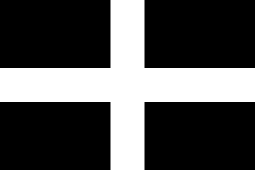St Ives School
The St Ives School refers to a group of artists living and working in the Cornish town of St Ives.[1] The term is often used to refer to the 20th century groups which sprung up after the First World War around such artists as Borlase Smart, however there was considerable artistic activity thre from the late 19th Century onwards.
History
The town became a magnet for artists following the extension to west Cornwall of the Great Western Railway in 1877.
Among others, Sydney Laurence, and Alexandrina Dupre, (a fellow artist he had met in New York City), after marrying in May 1889, sailed for England to pass the summer on the scenic coast at St Ives, where their stay in the fishing village and art colony eventually extended for nearly fifteen years.[2] Albert Julius Olsson was an important figure in the St Ives school of artists where, from circa 1890 to 1912, despite having little or no formal artistic training himself, he taught alongside Louis Grier and later Algernon Talmage. The latter tutored Emily Carr during her studies at St Ives in England (1899-1905) when Talmage lived and worked in his studio (then called 'The Cabin', located on Westcotts Quay, St Ives).[3] John Noble Barlow settled in St Ives in 1892, although later, he had a studio in the Lamorna Valley, Cornwall. Thomas Millie Dow moved with his family to St Ives in 1894, where Dow joined his friends and fellow painters Louis Grier and Lowell Dyer as members of the St Ives Art Club.[4]
The Sloop Inn in St Ives, located on the wharf, was the favourite haunt of Victorian artists including Louis Grier. Many of his paintings hung there in earlier years.[5]
In 1920 Bernard Leach and Shoji Hamada set up a pottery in St Ives, creating a further international art connection for the town.
In 1928 Ben Nicholson and Christopher Wood visited St Ives where they were impressed by the work of local artist Alfred Wallis. This started another strand in the development of the Cornish fishing port as an artists' colony.
The St Ives School of Painting was established in the historic Porthmeor studios at the centre of St Ives' artists' quarter in 1938 by Borlase Smart and Leonard Fuller.[6]
With the outbreak of the Second World War in 1939, Ben Nicholson and his then wife the sculptor Barbara Hepworth settled in St Ives, establishing an outpost for the abstract avant-garde movement in west Cornwall. They were soon joined by the prominent Russian Constructivist sculptor Naum Gabo.
After the war ended, a new and younger generation of artists emerged, led by Hepworth and Nicholson (Gabo departed in 1946). From about 1950 a group of younger artists gathered in St Ives who included Peter Lanyon, John Wells, Roger Hilton, Bryan Wynter, Patrick Heron, Terry Frost, Alexander Mackenzie, Harry Ousey, Wilhelmina Barns-Graham, Stass Paraskos, Paul Feiler, and Karl Weschke together with the pioneer modern potter, Bernard Leach (Nicholson departed in 1958), and including, for a while, Sven Berlin. It is with this group, together with Hepworth and Nicholson, that the term 'St Ives School' is particularly associated.[1]
A 2010 ninety-minute BBC 4 film, "The Art of Cornwall," presented by James Fox[7][8] explored in some detail the lives and works of many of the key figures and the contributions they made in establishing St Ives as a major centre of British art from the 1920s onwards. Helen Hoyle's review of this programme[9] is also very informative.
St Ives School today
The heyday of the St Ives School was in the 1950s and 1960s but in 1993, Tate St Ives, a purpose-built new gallery overlooking Porthmeor Beach was opened which exhibits the Tate collection of St Ives School art.
See also
References
- 1 2 Tate St Ives, St Ives School, Tate Gallery Accessed 9 September 2017.
- ↑ Sydney Laurence biography at alaskahistory.org Accessed 9 September 2017
- ↑ Grove Art Online. Oxford University Press, accessed 20 April 2008.
- ↑ Grier, Louis The Studio Vol V (1895). See photograph "Some members" p 111.
- ↑ Whybrow, Marion (1994). St Ives, 1883-1993: portrait of an art colony. Antique Collectors' Club. ISBN 978-1-85149-170-4. Retrieved 16 October 2011.
- ↑ "Our History". schoolofpainting.co.uk. UK: St Ives School of Painting. Retrieved 2 September 2016.
- ↑ The Art of Cornwall - "...eight artists who most made this miracle possible, from Kit Wood and Alfred Wallis to Barbara Hepworth and Ben Nicholson, are featured in a documentary which offers an alternative history of the 20th century avant-garde...", BBC Accessed 9 September 2017
- ↑ The Art of Cornwall-00 introduction, YouTube.
- ↑ Helen Hoyle, review of The Art of Cornwall, artcornwall.org. Accessed 9 September 2017
External links
- Walker, John. (1992) "St Ives School". Glossary of Art, Architecture & Design since 1945, 3rd. ed.
- St Ives School of Painting website
- St Ives Society of Artists
